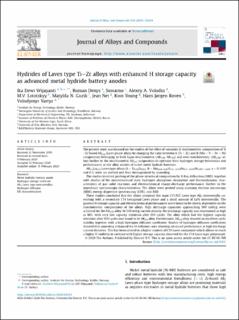| dc.contributor.author | Wijayanti, Ika Dewi | |
| dc.contributor.author | Denys, Roman Volodymyrovich | |
| dc.contributor.author | Suwarno, Suwarno | |
| dc.contributor.author | Volodin, Alexei A. | |
| dc.contributor.author | Lototskyy, Mykhaylo V. | |
| dc.contributor.author | Guzik, Matylda N. | |
| dc.contributor.author | Nei, Jean | |
| dc.contributor.author | Young, Kwo | |
| dc.contributor.author | Roven, Hans Jørgen | |
| dc.contributor.author | Yartys, Volodymyr | |
| dc.date.accessioned | 2020-04-24T08:20:55Z | |
| dc.date.available | 2020-04-24T08:20:55Z | |
| dc.date.created | 2020-04-08T12:14:41Z | |
| dc.date.issued | 2020 | |
| dc.identifier.citation | Journal of Alloys and Compounds. 2020, 828 . | en_US |
| dc.identifier.issn | 0925-8388 | |
| dc.identifier.uri | https://hdl.handle.net/11250/2652352 | |
| dc.description.abstract | The present work was focused on the studies of the effect of variation of stoichiometric composition of Ti–Zr based AB2±x Laves phase alloys by changing the ratio between A (Ti + Zr) and B (Mn + V + Fe + Ni) components belonging to both hypo-stoichiometric (AB1.90, AB1.95) and over-stoichiometric (AB2.08) alloys further to the stoichiometric AB2.0 composition to optimize their hydrogen storage behaviours and performances as the alloy anodes of nickel metal hydride batteries.
AB2-xLa0.03 Laves type alloys (A = Ti0.15Zr0.85; B = Mn0.64–0.69V0.11–0.119Fe0.11–0.119Ni1.097–1.184; x = 0, 0.05 and 0.1) were arc melted and then homogenized by annealing.
The studies involved probing of the phase-structural composition by X-Ray diffraction (XRD), together with studies of the microstructural state, hydrogen absorption–desorption and thermodynamic characteristics of gas–solid reactions and electrochemical charge-discharge performance, further to the impedance spectroscopy characterization. The alloys were probed using scanning electron microscopy (SEM), energy dispersive spectroscopy (EDS), and XRD.
These studies concluded that the alloys contained the main C15 FCC Laves type AB2 intermetallic co-existing with a secondary C14 hexagonal Laves phase and a small amount of LaNi intermetallic. The gaseous H storage capacity and electrochemical performances were found to be closely dependent on the stoichiometric compositions of the alloys. High discharge capacities approaching 500 mAh/g were achieved for the AB1.95 alloy. At 500 mA/g current density, the discharge capacity was maintained as high as 80%, with very low capacity retention after 500 cycles. The alloy which had the highest capacity retention after 500 cycles was found to be AB2.0 alloy. Furthermore, AB2.0 alloy showed an excellent cyclic stability together with a high hydrogen diffusion coefficient. Studies of hydrogen diffusion coefficients showed that annealing enhanced the H diffusion rates allowing advanced performance at high discharge current densities. This has been related to a higher content of C15 Laves compound which allows to reach a higher H mobility in contrast with higher storage capacity observed for the C14 Laves type polymorph. | en_US |
| dc.language.iso | eng | en_US |
| dc.publisher | Elsevier | en_US |
| dc.rights | Attribution-NonCommercial-NoDerivatives 4.0 Internasjonal | * |
| dc.rights.uri | http://creativecommons.org/licenses/by-nc-nd/4.0/deed.no | * |
| dc.title | Hydrides of Laves type Ti–Zr alloys with enhanced H storage capacity as advanced metal hydride battery anodes | en_US |
| dc.type | Peer reviewed | en_US |
| dc.type | Journal article | en_US |
| dc.description.version | publishedVersion | en_US |
| dc.source.pagenumber | 12 | en_US |
| dc.source.volume | 828 | en_US |
| dc.source.journal | Journal of Alloys and Compounds | en_US |
| dc.identifier.doi | 10.1016/j.jallcom.2020.154354 | |
| dc.identifier.cristin | 1805658 | |
| dc.relation.project | EC/H2020/778307 | en_US |
| dc.description.localcode | © 2020 The Authors. Published by Elsevier B.V. This is an open access article under the CC BY-NC-ND license (http://creativecommons.org/licenses/by-nc-nd/4.0/). | en_US |
| cristin.ispublished | true | |
| cristin.fulltext | original | |
| cristin.qualitycode | 1 | |

